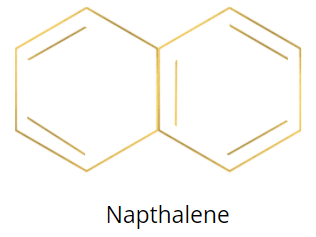
How to prove that naphthalene is an aromatic compound by using Huckel’s rule?
Answer
467.4k+ views
3 likes
Hint: To determine the answer to this question we should know the structure of the naphthalene and we should also know Huckel’s rule. The naphthalene is a bicyclic compound having two benzene rings joint at one-two positions. Huckel’s rule is used to determine that the given cyclic compound is aromatic or antiaromatic. Huckel gave two different formulas for aromatic and antiaromatic.
Complete step by step answer:
According to Huckel’s rule, the carbo-cyclic or heterocyclic compound having
- Aromatic compound:
- Anti-aromatic compound:
Where, n is a whole number that is used to satisfy Huckel’s rule.

Naphthalene has five pi bonds (two in the first ring and three in the second ring). Each pi bond has two electrons, so naphthalene has a total of ten pi delocalizing electrons.
We arbitrarily choose
When we substitute
When we substitute
We can calculate the
Naphthalene has ten pi electrons so, on substituting ten pi electrons in
As we are getting a whole number from,
Therefore, the naphthalene is an aromatic compound according to Huckel’s rule because it has
Note: Pi bonds are known as delocalized bonds. Pi bonds cause the resonance. Sigma bond cannot delocalize. The aromatic compounds are planer and have all
Complete step by step answer:
According to Huckel’s rule, the carbo-cyclic or heterocyclic compound having
- Aromatic compound:
- Anti-aromatic compound:
Where, n is a whole number that is used to satisfy Huckel’s rule.

Naphthalene has five pi bonds (two in the first ring and three in the second ring). Each pi bond has two electrons, so naphthalene has a total of ten pi delocalizing electrons.
We arbitrarily choose
When we substitute
When we substitute
We can calculate the
Naphthalene has ten pi electrons so, on substituting ten pi electrons in
As we are getting a whole number from,
Therefore, the naphthalene is an aromatic compound according to Huckel’s rule because it has
Note: Pi bonds are known as delocalized bonds. Pi bonds cause the resonance. Sigma bond cannot delocalize. The aromatic compounds are planer and have all
Recently Updated Pages
Master Class 9 General Knowledge: Engaging Questions & Answers for Success

Master Class 9 English: Engaging Questions & Answers for Success

Master Class 9 Science: Engaging Questions & Answers for Success

Master Class 9 Social Science: Engaging Questions & Answers for Success

Master Class 9 Maths: Engaging Questions & Answers for Success

Class 9 Question and Answer - Your Ultimate Solutions Guide

Trending doubts
Give 10 examples of unisexual and bisexual flowers

Draw a labelled sketch of the human eye class 12 physics CBSE

Differentiate between homogeneous and heterogeneous class 12 chemistry CBSE

Differentiate between insitu conservation and exsitu class 12 biology CBSE

What are the major means of transport Explain each class 12 social science CBSE

a Tabulate the differences in the characteristics of class 12 chemistry CBSE




